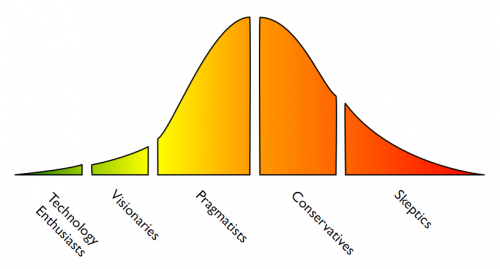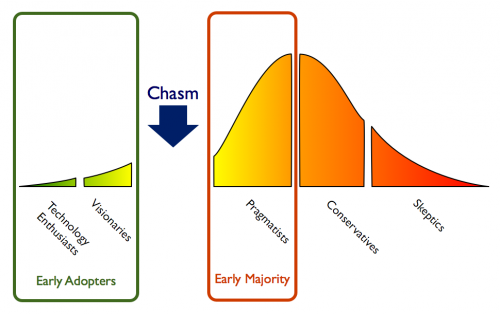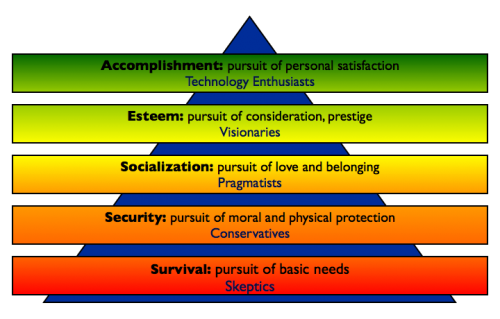You did everything you could to spread the use of a social platform at your organization. After months or years of effort and passion, you find that only a minority of early adopters – typically between 10 and 25% of the total target population – actually use the platform on a frequent basis. Even worse, you may find that there are as many haters of the new platform as there are fans of it. Then you start second guessing yourself, your implementation plan, or even the idea that social platforms can actually deliver the goods. If that is happening to you, you may be looking at the wrong target. By understanding what drives people to do things you may be able to create a roadmap that matches “needs” with “wants,” and perhaps reach the elusive target of total adoption.

The most popular approach used to understand how people adopt and embrace innovation is the bell-shaped technology adoption lifecycle model, built by Everett Rogers and others at the Iowa State University:

(illustration by Aaron Kim)
The technology adoption lifecycle model describes the adoption or acceptance of a new product or innovation, according to the demographic and psychological characteristics of defined adopter groups. The process of adoption over time is typically illustrated as a classical normal distribution or “bell curve.” (Source: Wikipedia)
You’ll see some slight variations on the names for each adopter group, but they are typically described as follows:
- Technology enthusiasts / innovators – more risk-oriented and always looking for change and challenging the status quo
- Visionaries / early adopters – those with a keen interest on everything new
- Pragmatists / early majority – somewhat conservative but open to new ideas, active in community and influencial to neighbours
- Conservatives / late majority – fairly conservative and less socially active
- Skeptics / laggards – very conservative, averse to change
Even though this is a very solid and proven model, what is often missed when applying it is that not all innovation ends up reaching the full adoption spectrum. While most people have cars, landline phones and TVs, not everybody has hybrid cars, smart phones and cable, and even fewer people use car sharing pools, tablets and Netflix. While Facebook brags about having one billion active users, and Google Plus and Twitter seem to be around the 500 million mark, there are still many more people who do not use them than people who do. As described by Geoffrey A. Moore in his book Crossing the Chasm, the transition between visionaries (early adopters) and pragmatists (early majority) is very difficult to overcome, and some technologies never manage to do it:

(illustration by Aaron Kim)
When it comes to workplace technologies, phones, email and intranets have percolated the full adoption spectrum, and while some may still hate them, most people came to accept them as cornerstones of their individual toolset to get work done. Social platforms are not there yet. In their narrowest form of status updates, walls, “likes”, wikis, communities and discussion forums, they may actually never cross the adoption chasm. The same way some people will never tweet or use Facebook, some people will simply refuse to use a social platform for work, no matter how hard you try to convince them.
That’s not to say that your enterprise social platform is doomed to fail or to be a niche product. On the contrary. What you have to realize is that all the evangelizing efforts about the value of social will only take you past the first two adoption groups. If you are really good in that, you may even manage to get the pragmatists to use it. But the strategies and techniques used to bring those first three groups in are not going to work with the conservatives and skeptics. That’s where Maslow’s hierarchy of needs comes to rescue.
The original hierarchy of needs five-stage model includes:
- Biological and Physiological (survival) needs – air, food, drink, shelter, warmth, sex, sleep.
- Safety (security) needs – protection from elements, security, order, law, limits, stability.
- Social (socialization) needs – Belongingness and Love, – work group, family, affection, relationships.
- Esteem needs – self-esteem, achievement, mastery, independence, status, dominance, prestige, managerial responsibility.
- Self-Actualization (accomplishment) needs – realizing personal potential, self-fulfillment, seeking personal growth and peak experiences.
(Source: SimplyPsychology)
Interestingly enough, the two five-stage models discussed above can be roughly mapped to each other as follows:

(illustration by Aaron Kim)
The key to bring late adopters and laggards to use your social platform is to make the platform serve more basic needs, and not only those of socialization, prestige or personal accomplishment. Those “carrots” only attract the early adopters and possibly the “middle of the pack.” Exploit the “less social” capabilities of the platform, those that appeal to the very basic communication and information needs of all your employees, such as:
- Employee directory – by having all information available in the normal employee directory plus a profile picture and other extras, this may become the de facto place where people search for employee-related information.
- Reference repository – place all key reference information in the platform, making it the place to go, and have other non-social properties pointing to it. People looking for information will end up using your platform without realizing it’s social. A glossary of acronyms and abbreviations, a directory of policies and procedures and onboarding information are good starting points.
- Integrated search – combine your intranet search with your social search. As social search is heavily influenced by what is popular and what is used by many users, the ranking of results tend to be better than the ones that only reflect page-rank. As people start realizing that there is a wealth of goodness in the social platform that are not necessarily social in nature, they will be less inclined to reject it.
- Announcements – often you receive corporate announcements via email and delete them after reading it. By creating a persistent repository for announcements, you make people’s inbox a transient space to catch their attention, and the social platform the archive for future reference.
- Team calendars – with more and more people working from home, traveling on business, taking leaves of absence or simply taking days off, having a place where you can see at a glance who’s in and who’s out may be extremely helpful when organizing team events or planning for main activities.
- Support forums – have a question, can’t find it on search, and don’t know who to ask? Create your own internal version of Yahoo! Answers – hopefully better in the quality of answers than the original one 🙂 – so that your social platform becomes a sought-after resource to leverage the wisdom of your crowd. Laggards are unlikely to ask new questions, but they may benefit from questions and answers posted by others.
Make peace with the fact that you’ll never have everybody in your organization becoming a social bee and being vocal participants in your social platform. To be fair, none of the other tools can claim that: a lot of your emails go unread, unnoticed or unanswered, some of your intranet pages have just a handful of page views, and there is a humungous number of seldom used SharePoint repositories and wikis out there. But by making the social platform useful as information hubs for late adopters and laggards, you may finally achieve the 100% adoption you were looking for. Just don’t expect it to look Facebook-ish.






